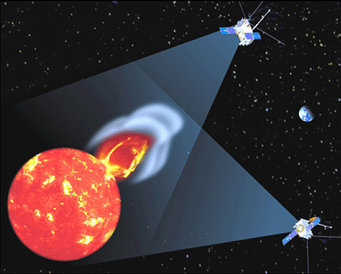A New Dimension in Solar Research
The Max Planck Institute for Solar System Research is participating in experiments on the NASA space probe STEREO
On October 25, 2006, two space probes from the STEREO mission were launched from the American space centre at Cape Canaveral, ushering in a new era in solar research. The Max Planck Institute for Solar System Research (MPS) in Katlenburg-Lindau is playing a major part in representing Germany on this international mission. Thanks to new 3-dimensional observation technology, the project is intended to improve our understanding of the processes on the sun’s surface and their effect on the earth’s atmosphere ("space weather").

The sun plays two conflicting roles for life on our earth. On the one hand it warms the earth to temperatures in which we can survive and thrive; on the other it sends out life-threatening UV radiation and electrically charged particles. This flow of particles, called solar wind, blows through the planetary system at speeds of several million kilometres per hour and consists primarily of hydrogen and helium ions. Twenty years ago, abrupt disturbances in the solar wind were discovered which were due to eruptions on the sun’s surface (fig. 1); their frequency varies over an 11 year cycle - from several per day to one every two weeks.
These eruptions hurl an enormous mass of gas into interplanetary space: up to ten billion tonnes (which is roughly equivalent to the mass of the granite Brocken Mountain in the Harz national park in Germany). These occasionally reach the earth, particularly during periods of maximum solar activity. Whereas the earth’s magnetic field diverts the normal solar wind 10 to 15 earth radii away from our planet, the enormous pressure of the gas clouds compresses the distance of this boundary area (the magnetopause) to half. This causes polar lights as far as Central Europe and exposes astronauts in space to an increased dose of radiation for several hours. The bombardment of particles can also destroy the electronic systems in telecommunications and television satellites.
The STEREO mission ("Solar TErrestrial RElations Observatory") is intended to improve the methods for investigating solar eruptions and solar wind. For seven years, the best research institutions in the world worked on the development of two almost identical probes under the project management of the American space agency NASA and Europe’s ESA. The Max Planck Institute for Solar System Research, in collaboration with the Universities of Kiel and Göttingen, contributed important components to the on-board telescope and particle detectors. The two probes, each weighing 620 kilograms and with the dimensions of a minibus (6.4 x 4.3 x 2.6 meters) were launched into orbit on a Delta II rocket.
After two to three months and several orbits of the earth, the moon redirected the observatories onto a path around the sun, where one probe orbited at a faster rate than the earth, the other at a slower rate. Seen from the sun, the probes move approximately 20 degrees further away from the earth each year.

As the distance between them increases, the probes provide two perspectives on the sun and surrounding space - in stereo, so to speak. Up to now, solar eruptions have been viewed from close to the earth and from one direction. This monocular view only permitted the observation of gas clouds which were accelerated at right angles to the earth, i.e. those not affecting us directly. Furthermore, particle showers did not show up well against the background of the sun.
The researchers now have "dual vision" and can create a three dimensional record of the sun’s surface and surroundings (the atmosphere, the corona and the heliosphere). Over and above the telescopes and cameras required for this purpose, there are more instruments installed on the STEREO probes which measure the energy-filled streams of particles from the front of the clouds and their radio emissions (fig. 3).

The scientists can now analyse the solar eruptions and the cosmic radiation they create in three dimensions. It is expected that this will make it possible to predict the arrival of gas clouds from solar eruptions in the earth’s atmosphere more accurately. As a particle shower of this kind takes two days to reach the Earth, the companies that operate satellites will have enough time to protect the delicate electronic systems they house.
The mission is initially planned to take two years. The researchers at MPS and numerous other institutes in the USA, Europe and Japan will however be working on analysing the data for several years to come. They are using various spectroscopic processes to accomplish this and aim to discover how to make reliable predictions about the eruptions and the direction in which the gas clouds spread. The work of the MPS on the STEREO mission was supported financially by the Federal Ministries for Research and Technology and Federal Ministry of Economics as part of a German Aerospace Center research sponsorship program.
Werner Deutsch, wdeutsch@mps.mpg.de, +49 05556 979 357
Dr. Axel Korth, korth@mps.mpg.de, +49 05556 979 430
Dr. Urs Mall, mall@mps.mpg.de, +49 05556 979 152
Borut Podlipnik, podlipnik@mps.mpg.de, +49 05556 979 227
Prof. Rainer Schwenn (Emeritus), schwenn@mps.mpg.de, +49 05556 979 337
Dr. Thomas Wiegelmann, wiegelmann@mps.mpg.de, +49 05556 979 155
Dr. Volker Bothmer, bothmer@astro.physik.uni-goettingen.de, +49 551 39 50425044


